Japanese Press Foreign Journalism Berdak Bayimbetov

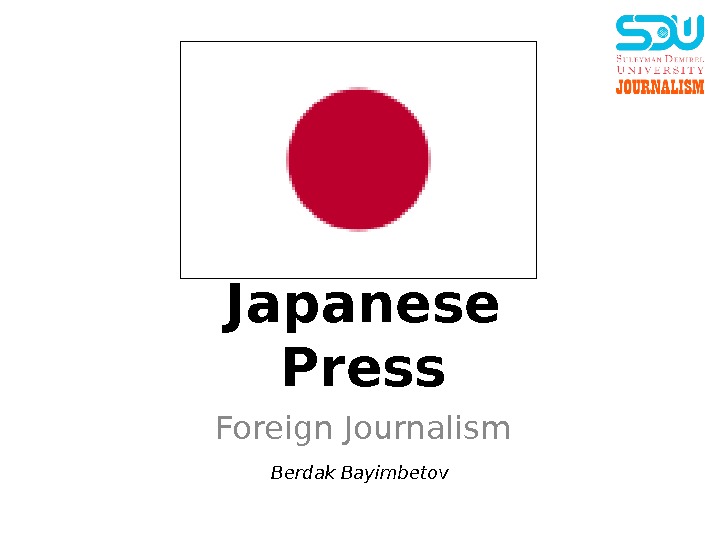
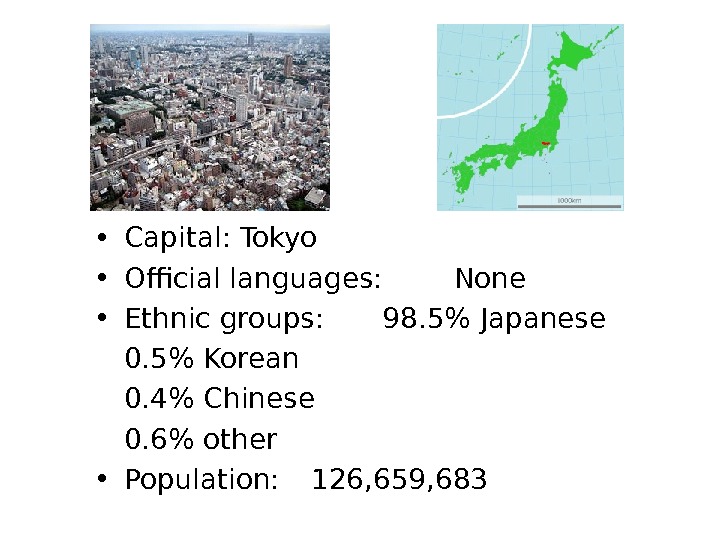
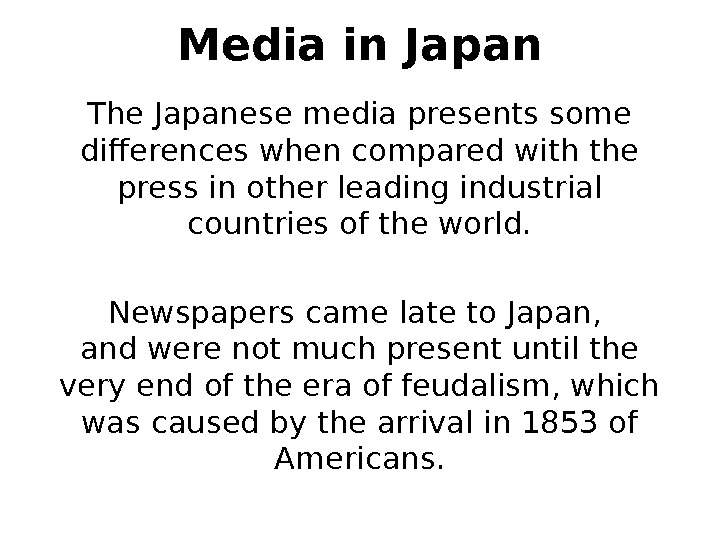
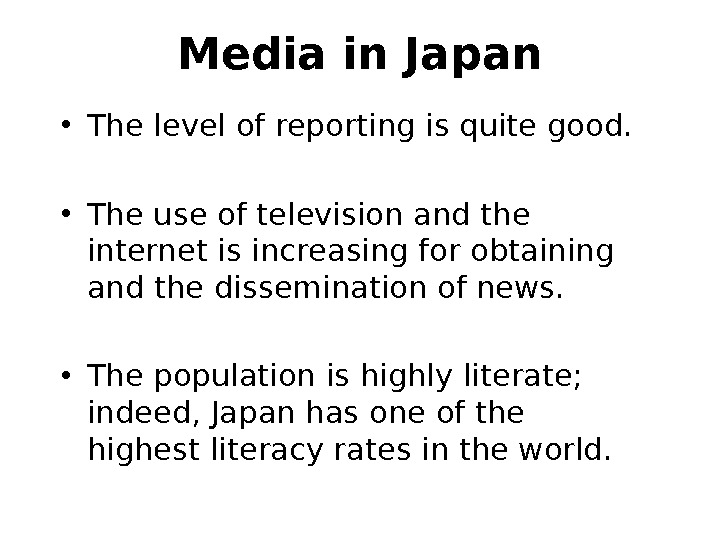
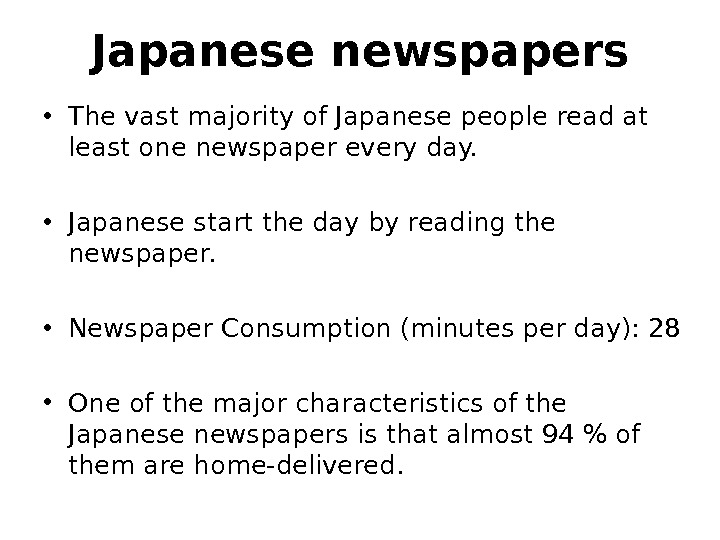
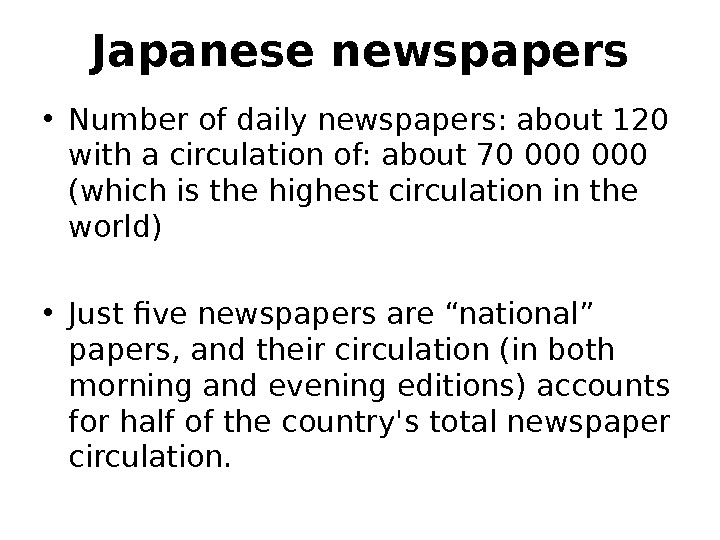
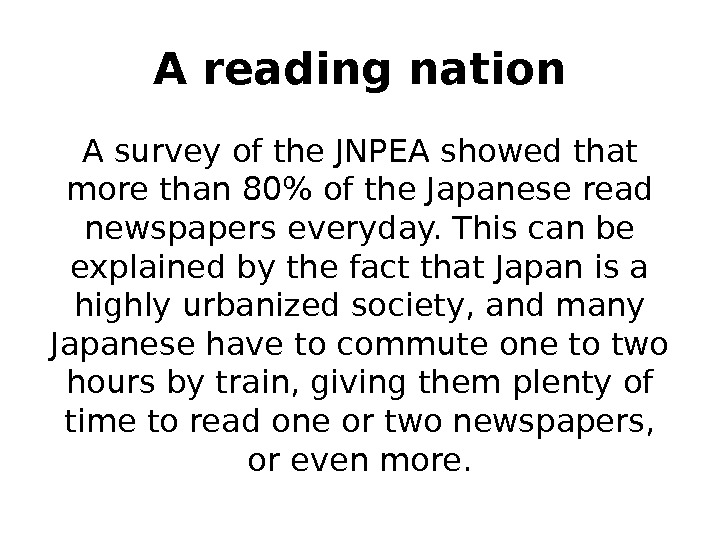
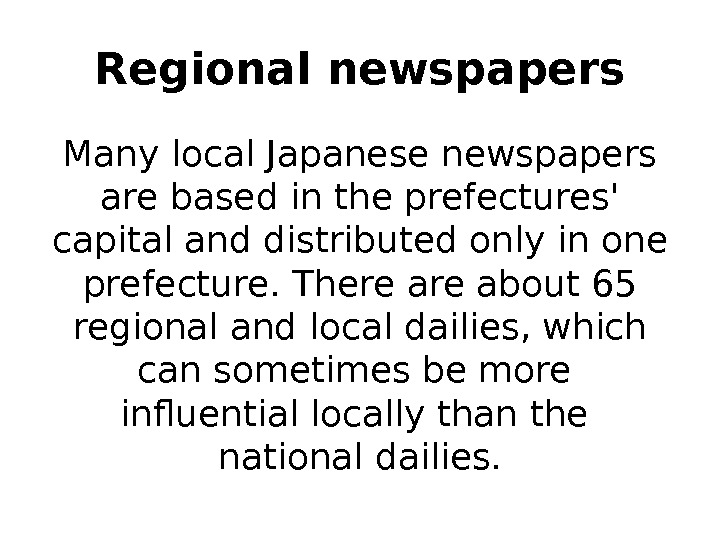
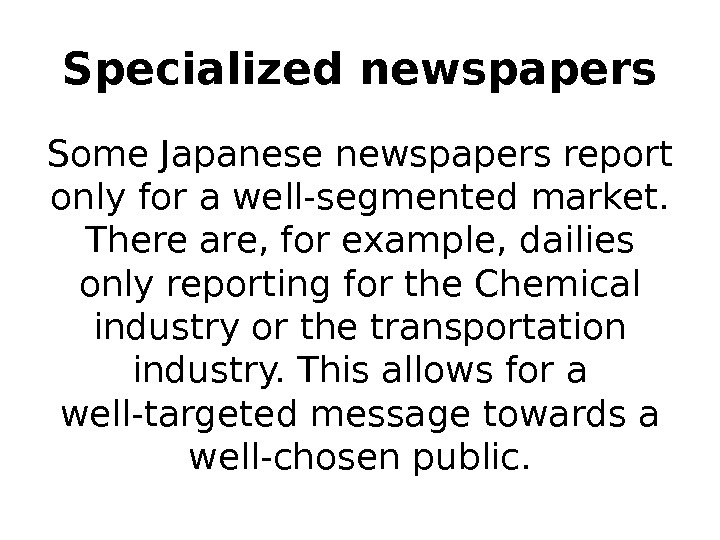
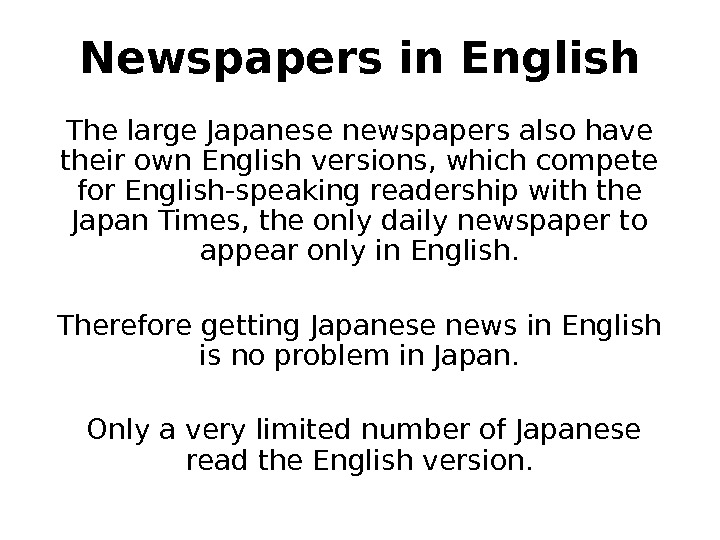
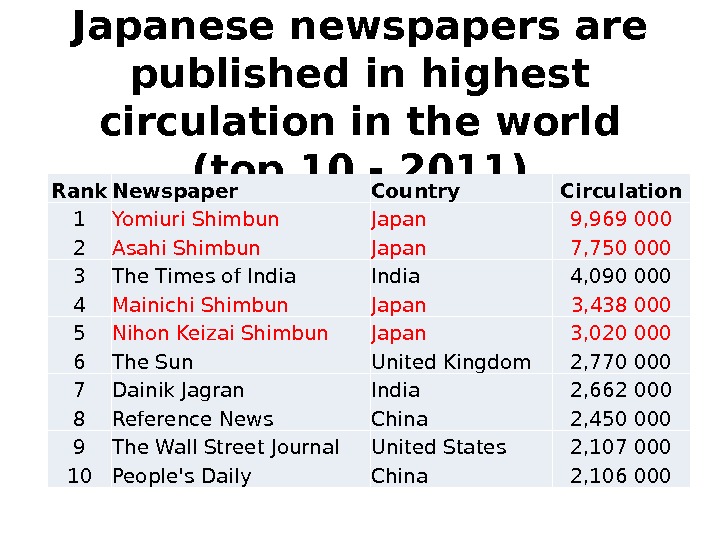
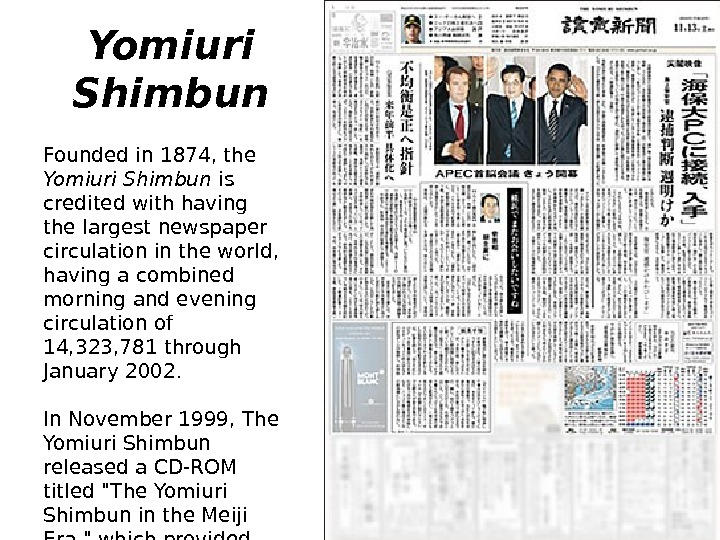
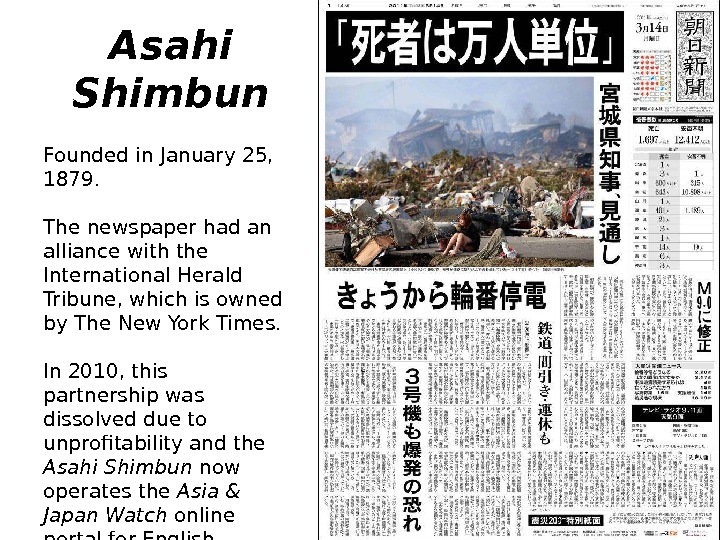
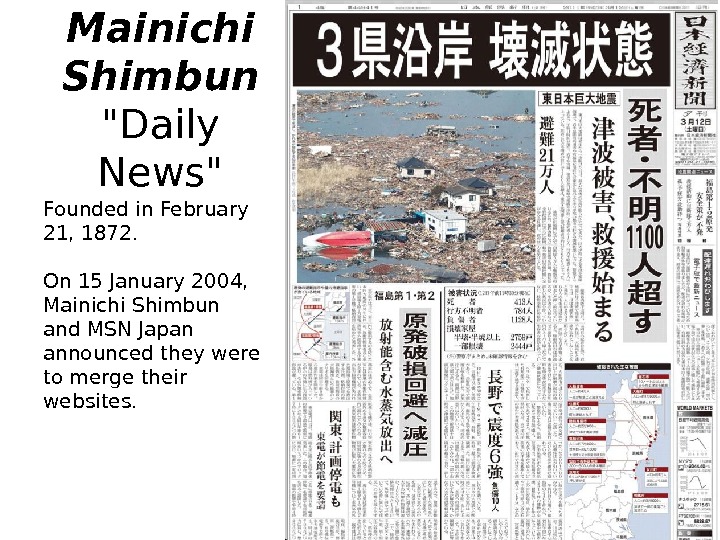
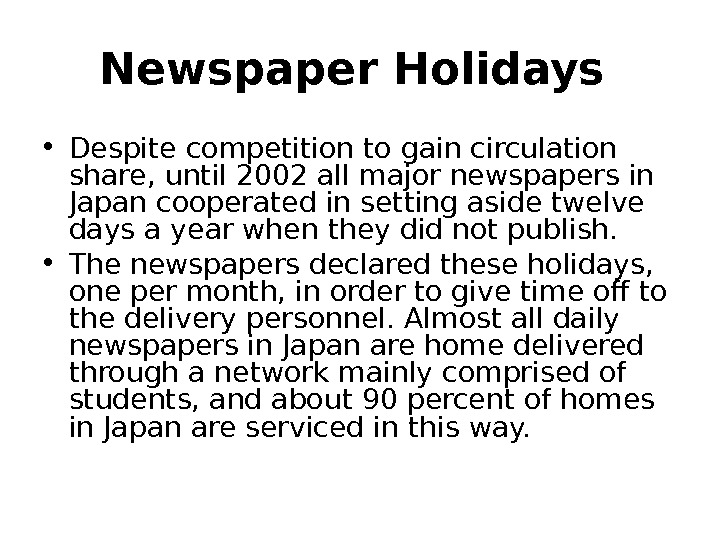
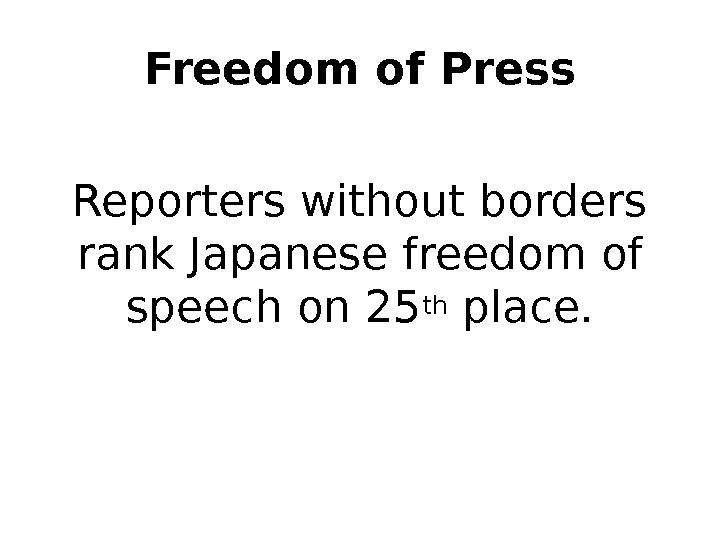
- Размер: 2.4 Mегабайта
- Количество слайдов: 16
Описание презентации Japanese Press Foreign Journalism Berdak Bayimbetov по слайдам
 Japanese Press Foreign Journalism Berdak Bayimbetov
Japanese Press Foreign Journalism Berdak Bayimbetov
 • Capital: Tokyo • Official languages: None • Ethnic groups: 98. 5% Japanese 0. 5% Korean 0. 4% Chinese 0. 6% other • Population: 126, 659,
• Capital: Tokyo • Official languages: None • Ethnic groups: 98. 5% Japanese 0. 5% Korean 0. 4% Chinese 0. 6% other • Population: 126, 659,
 Media in Japan The Japanese media presents some differences when compared with the press in other leading industrial countries of the world. Newspapers came late to Japan, and were not much present until the very end of the era of feudalism, which was caused by the arrival in 1853 of Americans.
Media in Japan The Japanese media presents some differences when compared with the press in other leading industrial countries of the world. Newspapers came late to Japan, and were not much present until the very end of the era of feudalism, which was caused by the arrival in 1853 of Americans.
 Media in Japan • The level of reporting is quite good. • The use of television and the internet is increasing for obtaining and the dissemination of news. • The population is highly literate; indeed, Japan has one of the highest literacy rates in the world.
Media in Japan • The level of reporting is quite good. • The use of television and the internet is increasing for obtaining and the dissemination of news. • The population is highly literate; indeed, Japan has one of the highest literacy rates in the world.
 Japanese newspapers • The vast majority of Japanese people read at least one newspaper every day. • Japanese start the day by reading the newspaper. • Newspaper Consumption (minutes per day): 28 • One of the major characteristics of the Japanese newspapers is that almost 94 % of them are home-delivered.
Japanese newspapers • The vast majority of Japanese people read at least one newspaper every day. • Japanese start the day by reading the newspaper. • Newspaper Consumption (minutes per day): 28 • One of the major characteristics of the Japanese newspapers is that almost 94 % of them are home-delivered.
 Japanese newspapers • Number of daily newspapers: about 120 with a circulation of: about 70 000 (which is the highest circulation in the world) • Just five newspapers are “national” papers, and their circulation (in both morning and evening editions) accounts for half of the country’s total newspaper circulation.
Japanese newspapers • Number of daily newspapers: about 120 with a circulation of: about 70 000 (which is the highest circulation in the world) • Just five newspapers are “national” papers, and their circulation (in both morning and evening editions) accounts for half of the country’s total newspaper circulation.
 A reading nation A survey of the JNPEA showed that more than 80% of the Japanese read newspapers everyday. This can be explained by the fact that Japan is a highly urbanized society, and many Japanese have to commute one to two hours by train, giving them plenty of time to read one or two newspapers, or even more.
A reading nation A survey of the JNPEA showed that more than 80% of the Japanese read newspapers everyday. This can be explained by the fact that Japan is a highly urbanized society, and many Japanese have to commute one to two hours by train, giving them plenty of time to read one or two newspapers, or even more.
 Regional newspapers Many local Japanese newspapers are based in the prefectures’ capital and distributed only in one prefecture. There about 65 regional and local dailies, which can sometimes be more influential locally than the national dailies.
Regional newspapers Many local Japanese newspapers are based in the prefectures’ capital and distributed only in one prefecture. There about 65 regional and local dailies, which can sometimes be more influential locally than the national dailies.
 Specialized newspapers Some Japanese newspapers report only for a well-segmented market. There are, for example, dailies only reporting for the Chemical industry or the transportation industry. This allows for a well-targeted message towards a well-chosen public.
Specialized newspapers Some Japanese newspapers report only for a well-segmented market. There are, for example, dailies only reporting for the Chemical industry or the transportation industry. This allows for a well-targeted message towards a well-chosen public.
 Newspapers in English The large Japanese newspapers also have their own English versions, which compete for English-speaking readership with the Japan Times, the only daily newspaper to appear only in English. Therefore getting Japanese news in English is no problem in Japan. Only a very limited number of Japanese read the English version.
Newspapers in English The large Japanese newspapers also have their own English versions, which compete for English-speaking readership with the Japan Times, the only daily newspaper to appear only in English. Therefore getting Japanese news in English is no problem in Japan. Only a very limited number of Japanese read the English version.
 Japanese newspapers are published in highest circulation in the world (top 10 — 2011) Rank Newspaper Country Circulation 1 Yomiuri Shimbun Japan 9, 969 000 2 Asahi Shimbun Japan 7, 750 000 3 The Times of India 4, 090 000 4 Mainichi Shimbun Japan 3, 438 000 5 Nihon Keizai Shimbun Japan 3, 020 000 6 The Sun United Kingdom 2, 770 000 7 Dainik Jagran India 2, 662 000 8 Reference News China 2, 450 000 9 The Wall Street Journal United States 2, 107 000 10 People’s Daily China 2,
Japanese newspapers are published in highest circulation in the world (top 10 — 2011) Rank Newspaper Country Circulation 1 Yomiuri Shimbun Japan 9, 969 000 2 Asahi Shimbun Japan 7, 750 000 3 The Times of India 4, 090 000 4 Mainichi Shimbun Japan 3, 438 000 5 Nihon Keizai Shimbun Japan 3, 020 000 6 The Sun United Kingdom 2, 770 000 7 Dainik Jagran India 2, 662 000 8 Reference News China 2, 450 000 9 The Wall Street Journal United States 2, 107 000 10 People’s Daily China 2,
 Yomiuri Shimbun Founded in 1874, the Yomiuri Shimbun is credited with having the largest newspaper circulation in the world, having a combined morning and evening circulation of 14, 323, 781 through January 2002. In November 1999, The Yomiuri Shimbun released a CD-ROM titled «The Yomiuri Shimbun in the Meiji Era, » which provided searchable archives of news articles and images
Yomiuri Shimbun Founded in 1874, the Yomiuri Shimbun is credited with having the largest newspaper circulation in the world, having a combined morning and evening circulation of 14, 323, 781 through January 2002. In November 1999, The Yomiuri Shimbun released a CD-ROM titled «The Yomiuri Shimbun in the Meiji Era, » which provided searchable archives of news articles and images
 Asahi Shimbun Founded in January 25, 1879. The newspaper had an alliance with the International Herald Tribune, which is owned by The New York Times. In 2010, this partnership was dissolved due to unprofitability and the Asahi Shimbun now operates the Asia & Japan Watch online portal for English readers.
Asahi Shimbun Founded in January 25, 1879. The newspaper had an alliance with the International Herald Tribune, which is owned by The New York Times. In 2010, this partnership was dissolved due to unprofitability and the Asahi Shimbun now operates the Asia & Japan Watch online portal for English readers.
 Mainichi Shimbun «Daily News» Founded in February 21, 1872. On 15 January 2004, Mainichi Shimbun and MSN Japan announced they were to merge their websites.
Mainichi Shimbun «Daily News» Founded in February 21, 1872. On 15 January 2004, Mainichi Shimbun and MSN Japan announced they were to merge their websites.
 Newspaper Holidays • Despite competition to gain circulation share, until 2002 all major newspapers in Japan cooperated in setting aside twelve days a year when they did not publish. • The newspapers declared these holidays, one per month, in order to give time off to the delivery personnel. Almost all daily newspapers in Japan are home delivered through a network mainly comprised of students, and about 90 percent of homes in Japan are serviced in this way.
Newspaper Holidays • Despite competition to gain circulation share, until 2002 all major newspapers in Japan cooperated in setting aside twelve days a year when they did not publish. • The newspapers declared these holidays, one per month, in order to give time off to the delivery personnel. Almost all daily newspapers in Japan are home delivered through a network mainly comprised of students, and about 90 percent of homes in Japan are serviced in this way.
 Freedom of Press Reporters without borders rank Japanese freedom of speech on 25 th place.
Freedom of Press Reporters without borders rank Japanese freedom of speech on 25 th place.

